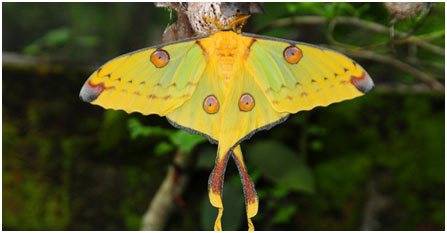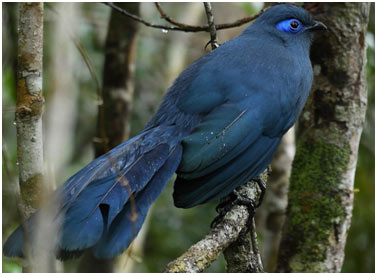Unique facts about Madagascar
- Madagascar is the fourth largest island in the world with an area of 587,041 km2.
- Madagascar coastline is 5000 km consists of beautiful beaches and coral reefs.
- Madagascar is one of the major suppliers of coffee, cloves, vanilla, and lychees.
- 90% of the wildlife is endemic which means that cannot be found elsewhere in the world.
- The famous Madagascar periwinkle is used to produce drugs for the treatment of cancers like leukemia.
- Madagascar has 3 world heritage sites by UNESCO.
Wildlife of Madagascar
Madagascar is a location that stimulates curiosity; where nature has progressed at its own speed and under its own guidelines. The island of Madagascar is home to nearly 25,000 species of wild animals with a good number being threatened species. Most of these species found in Madagascar are endemic, implying they cannot be found anywhere else in the world. Here the list of 11 amazing animals found just in Madagascar.
Lemurs
Madagascar is the only place in the world where lemurs are present in the wild; the island’s lack of predators and its seclusion from the remainder of the world has actually ensured they thrive. Lemurs are primates that look like an animal in between a dog, a cat, and a squirrel that have exceptionally unique and amazing habits that include singing like a whale.

There are more than thirty types of lemurs in Madagascar today that vary in size from 25 gms pygmy lemur to the biggest Indri Lemur weighing more than 12 kgs. Lemurs are among the most threatened animals on the entire planet and according to IUCN Red List of Threatened species, 22 species of lemurs are critically threatened, 48 are endangered, while 20 are vulnerable.
Aye-aye
Aye-aye is the biggest nocturnal primate in the world. They can be only found in Madagascar. They are dark brown in color and have big eyes and slender fingers. All these make aye-aye looks so frightening. Although, they are very gentle and harmless.

But many people kill them on sight because of their frightening look. Such searching and environmental loss make aye-aye one of the endangered animals of Madagascar. Aye-aye utilizes its big, delicate ears to spot the wood-boring larvae and take them out with their extended middle finger. The diet of aye-aye likewise consists of seeds, fruits, and nectar.
Madagascar Hissing Cockroach
Madagascar hissing cockroaches are oval-shaped and glossy brown bugs without wings. The male has horns that he uses in aggressive battles that are more like mammals. Throughout the conflict, the roaches hiss, for this reason where they got their name.

The cockroach that wins the battle hisses more than the loser. Unlike a lot of insects that make noise by rubbing parts of their body parts together or vibrating the membranes, the Madagascar cockroach surprisingly utilizes their breathing holes by breathing out air, a behavior typical to vertebrates. The bug has a life expectancy of between two and five years and grows to between 2 and 3 inches (5-7cm) long.
Fossa
The fossa is the biggest predator found just in the forest of Madagascar. This mammal can reach 6 feet in length and weigh up to 10 kg. In the beginning look, the fossa provides a look of a cross between a mongoose and a cat. The fossas are also the top predator of Madagascar.

Regrettably, just a little population of Fossas are left in wild in the Madagascar. Habitat loss is the primary reason for the declination of the fossa’s population in Madagascar. The fossa’s hunt during both day and night. With sharp claws and sharp teeth, fossas can rapidly kill their victim. Lemurs are the main food of fossas. They also hunt on other small mammals, fishes, birds, frogs, and lizards.
Tomato Frogs
Tomato frogs are present just in Madagascar, mainly in the northwestern region of the island, and are mainly terrestrial, residing in the forested areas.

Due to deforestation, their habitat has been destroyed but apparently, they adapt well to the cultivated locations, and they prevail in gardens. They are brilliantly colored and ooze off some white sticky mucous when threatened, though they are not hazardous, they are irritating to the mucous membrane.
Indri
There are 50 various kinds of lemur that reside in the forests of Madagascar. Indri is the largest of all lemurs discovered on Madagascar Island. They have a body length between 22-28 inches and weigh approximately 10 kg. Indris are likewise among the endangered types of lemur with a population less than 10000.

They are arboreal primates, indicates specifically adjusted to move between the trees. Indris have effective legs and huge toes that give a strong grip on getting the branches of trees. This fantastic lemur can cross a distance of up to 10 meters in a single dive.
Comet Moth
The comet moth or Madagascan moon moth is among the most gorgeous moths worldwide discovered just in Madagascar. They are amongst the largest on the planet with a wingspan that extends to 20 cm coming only 2nd after the Atlas moth of Asia. The insect has an intense yellow color and with a long tail and is nocturnal. The females are broader– their wings are rounder, and their tail is also much shorter than the males. To this day these beautiful animals have no protection status, and their population status has not been developed.

Panther Chameleon
With a size of a house cat, the panther chameleon is amongst the biggest chameleons in the world. They are 17-20 inches in length. This big species of chameleon is native to Madagascar Island. The panther chameleons are likewise well-known for their striking technicolor skin.

Panther chameleons have the ability to change their color with incredible speed. This magnificent color altering doesn’t merely depend upon the modification of area. It is likewise affected by their state of feeling, health, temperature variation, and light intensity.
Blue Coua
Madagascar Island is house to almost 250 different types of birds. However, 44% of them are found no place else in the world. One of such unique birds of Madagascar is the blue coua. It is a non-parasitic member of the cuckoo bird family. The blue couas are also called Madagascar coucal.

They are renowned for their striking deep blue plumage. The dark blue plumage and light blue skin around their eye are very appealing. Regrettably, this stunning bird of Madagascar may go extinct in the near future due to hunting. Unlike other cuckoo birds, the blue couas construct their own nests. They utilize the leaves and branches to develop their nest. The nests of blue couas normally stay concealed in the trees or bushes. They just lay one egg during the reproducing season. Remarkably, blue couas also incubate their own eggs.
Giraffe Weevil
The giraffe weevil is a weird-looking insect that is endemic to the forests of Madagascar. The giraffe weevil called so because of its tremendously long neck. A male giraffe’s weevil’s neck is 2-3 times longer than the females. At present, a large population of giraffe weevils lives in the forests of Madagascar.

They spent the majority of their lives on little trees called ‘giraffe beetle trees’. They also eat the leaves of these trees. Fortunately, there are no recognized predators to the giraffe weevils. Unlike their weird look, the giraffe weevil is totally safe. They show no aggressiveness towards humans or other species.
Satanic Leaf-Tailed Gecko
The Satanic leaf-tailed gecko is a spectacular reptile that can camouflage itself in its environment. The body can mix and simulates dead leaves in its environment so that they cannot be recognized by its predators. The body is twisted with patterned skin, while the tail looks astonishingly like a leaf munched by pests, all these characteristics help the gecko to mix into the surrounding foliage. Lately, there has actually been dropping in their population in the wild, and this makes it susceptible to extinction.


